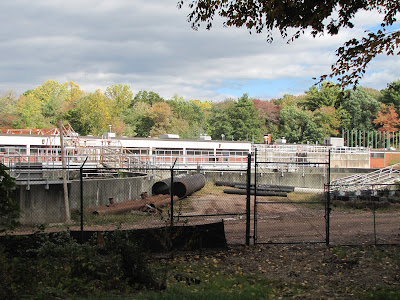1. A quest for an uncommon bird. In this case, a Connecticut Warbler. The ornithologist who first recorded the species was no doubt at the end of his rope trying to come up with yet another way to name a yellow warbler and just settled on the place where he saw it. Little did he know that it's barely ever seen in Connecticut. If he'd called it something more apt, like Thicket-skulking Warbler or Honking Great Big Ground-foraging Warbler, I probably wouldn't have been so keen to see it. There was just something about seeing a Connecticut Warbler in Connecticut. On my birthday.
 |
| No, I don't have a photo of a Connecticut Warbler -- because you know where this quest is heading, right? Instead, here is a Connecticut Warbler (top), Mourning Warbler, and MacGillivray's Warbler illustrated by Louis Agassiz Fuertes. |
2. Bizarre directions. Turn left at the red toy truck. Keep following the river until you find a tree with chicken wire wrapped around the base, lying by the side of the trail. That kind of thing.
3. The right companion to share the expedition with. You need someone who will approach the quest with the requisite gravity.
 |
| Frank Gallo, birding companion extraordinaire |
4. A sewage treatment plant. They call them water treatment plants now, but we all know what they are. And no birding birthday is complete without one.
5. High-tension power lines. These are a must on
any birding expedition, really. The bizarre directions (see point 2) must include a reference to them, e.g., "You want to be on the other side of the power cut." Preferably they will be pulsing and throbbing and crackling in a way that makes you walk really, really quickly through that power cut.
6. A fleeting glance of bird that could be the bird you're looking for. On the way to your ultimate location (e.g., fallen log with chicken wire around base), you should get a very quick sighting of a bird that may fit the description of the rare bird -- or not. For instance, you might notice a gray hood and a yellow body but no other details. It could be a Connecticut Warbler. It could be a Mourning Warbler. It could be a Nashville Warbler. But you will never know, because it has disappeared into an overgrown thicket and will never be seen again by human eyes.
7. Several hours of staring at one spot. The spot should be densely vegetated, almost entirely with weeds. It could also be a slushy bog with an unidentifiable oily slick on top and an abandoned truck tire poking out. There is about a 99% chance that it won't be a picturesque meadow.
 |
| (Other) people had actually managed to see a Connecticut Warbler in there in previous days. |
8. Cool random stuff that you see while staring at one spot for hours.
 |
| A cicada |
 |
| A weird spiky fruit/gourd thing |
 |
| A caterpillar |
9. A temporary spike in your risk of a major cardiac event when your companion sees something yellow out of the corner of his eye. As your heart rhythm returns to normal, you realize it's only a Palm Warbler. But still, they are cute buggers, aren't they?
10. A sign from the heavens. Sure, you may still have never seen a Connecticut Warbler in Connecticut, but keep your eyes open. You just might see a heart-shaped cloud on the drive home...
 |
| Awwwwwww |










No comments:
Post a Comment